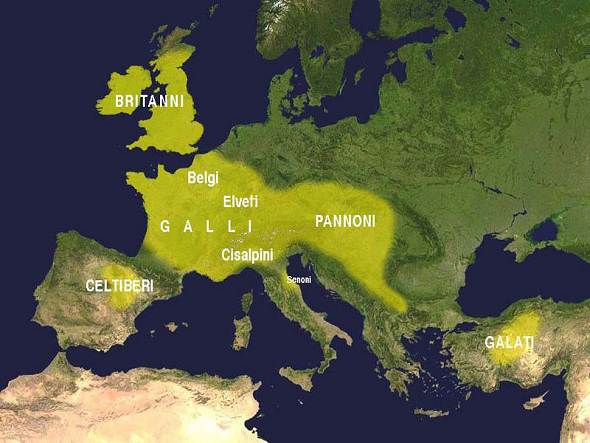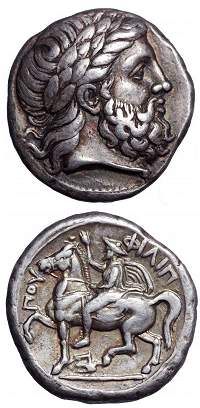Volume One
Ancient and Medieval States
Background
The Celts

The Celts were a group of Indo-European peoples who spread over much of Europe from the second millennium to the first century BC. Linguistically they survive in the Celtic speakers of Ireland, highland Scotland, the Isle of Man, Wales, and Brittany. The oldest unequivocal archaeological evidence comes from 700 BC graves at Hallstatt, near Salzburg, where chieftains used iron implements and traded in Greek luxury items such as bronze and pottery vessels. By the mid 5th century BC the La Tène culture, with its distinctive art style of abstract geometric designs and stylized bird and animal forms, emerged among the Celts centred on the middle Rhine. Trade seems to have been more with Etruscans than the Greeks. From the 5th to the 1st centures BC, the La Tène culture accompanied migrations of Celtic tribes into eastern Europe and westward into the British Isles. {1}
The first European societies probably practised a primitive communism, where food was jointly produced and jointly consumed by family units. By Celtish times these families had aggregated into clans or tribes, co-operating with each other in producing distinctive goods and exchanging men and women in marriage. Strict codes applied. Killing or injuring someone from another tribe saw the offending tribe pay blood-money. Offences against a same tribe member saw the offender outlawed, probably a death sentence when a livelihood outside these extended families was exceptionally difficult. {2}
Origins of the Celts
The Celts emerge into history when the Greeks invaded the Aegean area, learning bronze-working from the native inhabitants and soon turning out superior weapons themselves. Around 390 BC, the Celts sacked Rome, and remained a constant menace to Italy until their defeat at Telamon in 225 BC. Caesar's account of the Helvetii suggests that these were large tribes of free warriors under tribal chiefs. The object was conquest and settlement, and such migrations were accompanied by women and children. In western Europe the first Celtic invaders were the Gaels around 700 BC. They were followed two centuries later by the Bryons, who had learned the use of iron. A third wave of invaders, the Belgae from northern Gaul, arrived in England around 100 BC, mixing and intermarrying with their predecessors and native Iberian stock. {1}
 Information on Celtic institutions comes from classical authors and ancient Irish literature. The tribe had three social levels: king, warrior aristocracy, and freemen farmers. The druids, who were occupied with magico-religious duties, were recruited from the warrior class but ranked higher. There may also have been a semi-servile class who were exploited by kings and landowners once the tribe settled into a sedentary existence. As in other Indo-European systems, the family was patriarchal. The economy was based on mixed farming, and, except in times of unrest, single farmsteads were initially the usual order of things. Variations in terrain and climate allowed cattle rearing to be more important than cereal cultivation in some regions. The earlier light plough, which required two ploughings of square-shaped fields, gave way with the Belgae to iron-tipped heavy ploughs drawn by four or eight oxen. Hill forts provided places of refuge, but warfare was generally open, consisting of single combat as much as general fighting. Villages sprung up under the Belgae, and these were stockaded affairs in contrast to the hamlets and scattered homesteads of earlier invaders. The Belgae also kept in close contact with their Gaulish cousins, and traded with southern European and Mediterranean peoples. The Brythons employed iron bars resembling half-finished swords for currency, but the Belgae struck gold coins in imitation of Macedonian gold staters. La Tène art indeed bears witness to the aesthetic qualities of the Celts, and they also prized music and many forms of oral literary composition. {1, 2}
Information on Celtic institutions comes from classical authors and ancient Irish literature. The tribe had three social levels: king, warrior aristocracy, and freemen farmers. The druids, who were occupied with magico-religious duties, were recruited from the warrior class but ranked higher. There may also have been a semi-servile class who were exploited by kings and landowners once the tribe settled into a sedentary existence. As in other Indo-European systems, the family was patriarchal. The economy was based on mixed farming, and, except in times of unrest, single farmsteads were initially the usual order of things. Variations in terrain and climate allowed cattle rearing to be more important than cereal cultivation in some regions. The earlier light plough, which required two ploughings of square-shaped fields, gave way with the Belgae to iron-tipped heavy ploughs drawn by four or eight oxen. Hill forts provided places of refuge, but warfare was generally open, consisting of single combat as much as general fighting. Villages sprung up under the Belgae, and these were stockaded affairs in contrast to the hamlets and scattered homesteads of earlier invaders. The Belgae also kept in close contact with their Gaulish cousins, and traded with southern European and Mediterranean peoples. The Brythons employed iron bars resembling half-finished swords for currency, but the Belgae struck gold coins in imitation of Macedonian gold staters. La Tène art indeed bears witness to the aesthetic qualities of the Celts, and they also prized music and many forms of oral literary composition. {1, 2}
Because inscriptions, when they occur at all, generally refer to individuals rather than tribes, coins among the Celts may well have originated in special purposes: ritual, tribute, payment for military services, diplomatic gifts, dowries or gifts between specific members of the Celtic aristocracy. In this they resembled gold torques, which were certainly not used for trade. But once the coins were distributed, however, and their prestige diminished, then a secondary use for barter or trade became possible. Large issues were often payments to mercenary Celtic troops. Antigonas Gonatas of Macedon (283-239 BC) employed Celts at the rate of one stater per man, owing them each 30 talents (or more than 90,000 staters in all) at the end of the war. Perseus, the last King of Macedon, employed a force of Gaetae comprising 10,000 cavalry and 10,000 infantry. The foot soldiers were to receive 5 staters each, the horseman 10 staters and Clonicus, their leader, 1,000. Early coins were generally faithful copies of Greek originals, but became increasingly corrupted, when even the letters became ornamental.
The later appearance (2nd century BC) appearance of silver and bronze coinages in northern Gaul coincided with the Celtic oppida (fortified settlements) — urban centres that had evolved from a subsistence economy to craft specialisations also importing Roman goods. Coins in turn may well have evolved from one-off special purposes to general commercial purposes, i.e. from ritual donations and blood money to everyday exchange in trade and barter. {3}
Iconography of Celtish Coins
 As is well known, Celtic coins began as copies of the coinage of Greek, Macedonian and Roman peoples that Celtish tribes came into contact with through trade, war, and acting as mercenaries for. The first copies were often like their originals if rather crude, lacking their balance, finish and authority, but gradually developed in directions of their own, becoming more abstract and decorative, the individual features detaching themselves and turning into religious figures or symbols. {4-7} Thus the tetradrachm of Philip II of Macedon shown above becomes a decorative pattern in the gold stater shown opposite, one struck by the Triovantes, a Celtic tribe of 1st century BC Britain. {4} The head has become an ornate cross, and the reverse shows a horse galloping around free-wheeling motifs. Some authors believe these motives had religious significance. The Celts regarded the sun and moon as gods, for example, and where the wheel appears above the horse — as here — it will have represented the sun, perhaps alluding to its fiery passage through the heavens. {8-9} The other symbols here may again represent the sun and possibly a thunder-bolt: the Celts had sky deities but also spirits of the earth and the otherworld.
As is well known, Celtic coins began as copies of the coinage of Greek, Macedonian and Roman peoples that Celtish tribes came into contact with through trade, war, and acting as mercenaries for. The first copies were often like their originals if rather crude, lacking their balance, finish and authority, but gradually developed in directions of their own, becoming more abstract and decorative, the individual features detaching themselves and turning into religious figures or symbols. {4-7} Thus the tetradrachm of Philip II of Macedon shown above becomes a decorative pattern in the gold stater shown opposite, one struck by the Triovantes, a Celtic tribe of 1st century BC Britain. {4} The head has become an ornate cross, and the reverse shows a horse galloping around free-wheeling motifs. Some authors believe these motives had religious significance. The Celts regarded the sun and moon as gods, for example, and where the wheel appears above the horse — as here — it will have represented the sun, perhaps alluding to its fiery passage through the heavens. {8-9} The other symbols here may again represent the sun and possibly a thunder-bolt: the Celts had sky deities but also spirits of the earth and the otherworld.
At their best, coins indeed displayed what is common to all Celtic art: 'an exquisite sense of balance in the layout and development of patterns. Curvilinear forms are set out so that positive and negative, filled areas and spaces form a harmonious whole. Control and restraint were exercised in the use of surface texturing and relief. Very complex curvilinear patterns were designed to cover precisely the most awkward and irregularly shaped surfaces.' {10}
The Celts were led by a warrior aristocracy, given to fighting and feasting, and ornamenting themselves with marks of status: gold torques, bracelets and armlets. Wooden figurines are also found, sometimes in large quantities, and may be votive objects, standing proxy for human sacrifice (which may have been given gladly, to propitiate the gods and favour success in battle and farming {11}). In short, Celtic coins may have served several purposes, perhaps originating as talismen or reminders of the supernatural order and then sinking into the mundane as currency, a view that foreshadows our understanding of debt as both a moral obligation and a commercial transaction.
References and Further Reading
Need the 14 references and 3 illustration sources? Please consider the inexpensive ebook.
